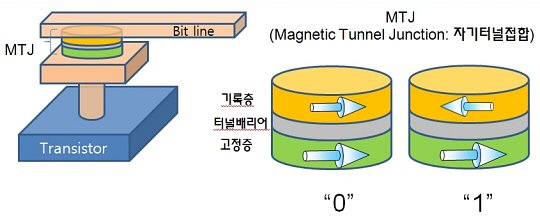Scientists find solution for preventing malfunction in next-generation 'magnetic memory'
성수 최 2009-11-06 View. 6,729Scientists find solution for preventing malfunction in next-generation 'magnetic memory'
Industry-academia-research institute joint research team succeeds in controlling recording by using quantum property A Korean research team has identified the mechanism for a malfunction that occurs in STT-MRAM(Spin-transfer torque magnetic memory), a next-generation memory technology, and discovered that said malfunction could be prevented by controlling the quantum effect.
The research team is comprised of members of academia, industry and research institutes, led by Prof. Lee Kyung-jin of the new materials department of Korea University, Dr. Oh Se-chung of Samsung Electronics, Dr. Park Seung-young of the Korea Basic Science Institute(KBSI), and Prof. Lee Hyun-woo of the physics department at the Pohang University of Science and Technology(POSTECH).
The study was supported by the senior researcher assistance program implemented by the Ministry of Education, Science and Technology(Minister Ahn Byung-man) and the Korea Research Foundation(Chairman Park Chan-mo), as well as the industry-academia collaboration program of Samsung Electronics, and KBSI and the Korea Institute of Science and Technology Information(KISTI). The results of the study were published in the October 25 issue of Nature Physics, a world-renowned physics journal.
STT-MRAM is a non-volatile memory technology that uses spin-transfer torque, a phenomenon in which the magnetic direction of a magnet shifts when electric voltage is applied to a small magnet. It is a next-generation memory technology that allows for ultra-high precision processing of below the 30-nanometer level, which is currently considered a technological barrier. Next-generation memory technologies include PRAM(Phase-Change RAM) and RRAM(Resistive RAM), as well as STT-MRAM(Spin-Transfer Magnetic RAM), while conventional memories include SRAM, DRAM, and Flash Memory.
[ Spin-Transfer Torque ]
It is a physical phenomenon wherein an electric current (or voltage) is injected into a magnetic substance, causing the injected electrons to be transferred to spins that comprise the magnetic substance, thus controlling the direction of the spins. It is a recording method for STT-MRAM, a new type of non-volatile memory, which major semiconductor makers in Korea and around the world are racing to research and develop.
Countries and companies that develop this memory technology are expected to lead the global memory chip market, and hence major semiconductor makers in advanced countries and around the world are striving to develop it. However, a major hurdle to STT-MRAM's commercialization has been a malfunction that occurs when it operates at a high speed.
The Korean research team discovered that the malfunction is caused by a unique dependence on the voltage of the spin-transfer torque. Moreover, the team successfully regulated the electric voltage dependence of the spin-transfer torque by controlling the quantum effect, and created a STT-MRAM that does not entail malfunctions.

(Photo) A diagram of STT-MRAM(left) and a conceptual diagram of magnetization reversal at a magnetic tunnel junction (MTJ) within STT-MRAM.
Countries and companies that develop this memory technology are expected to lead the global memory chip market, and hence major semiconductor makers in advanced countries and around the world are striving to develop it. However, a major hurdle to STT-MRAMA¢A?A™s commercialization has been a malfunction that occurs when it operates at a high speed.
The Korean research team discovered that the malfunction is caused by a unique dependence on the voltage of the spin-transfer torque. Moreover, the team successfully regulated the electric voltage dependence of the spin-transfer torque by controlling the quantum effect, and created a STT-MRAM that does not entail malfunctions.
Prof. Lee Kyung-jin, who oversaw the study, said, "This study is a good example of a case in which basic science has served the theoretical foundation that helps resolve a practical problem that occurs at the industry level", stressing the importance of basic science. He added, "Whereas conventional studies on memory devices focused on how the quantum effect could be prevented, studies on STT-MRAM have been able to produce better characteristics by proactively utilizing the quantum effect."
Dr. Oh Se-chug at Samsung Electronics said, "We have realized once again that basic science will determine future engines of growth and methods of survival and success in the future", addressing the importance of joint study between industry, academia and research institutes. He added, "We have confirmed the excellence of Korean technology by developing a solution to a core problem in STT-MRAM before our rivals could, at a time when major semiconductor makers around the world are staging fierce competition to develop STT-MRAM."
For the study, Prof. Lee at Korea University took charge of overall coordination, Dr. Oh at Samsung Electronics designed the device and experiment, Dr. Park at KBSI analyzed characteristics, and Prof. Lee at POSTECH was responsible for theoretical investigation.
?
Lim Dong-wook
duim at kofac.or.kr
?
[November 02, 2009]
- - - - - - -
Source - ScienceTimes

 Delete Article!
Delete Article!